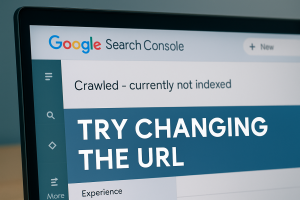Everywhere you look right now, someone’s talking about AI traffic.
The idea that ChatGPT, Perplexity, or other large language models (LLMs) are replacing Google and sending high-quality referral traffic is spreading fast, and a lot of people are taking it at face value.
But hype and data rarely tell the same story.
A new report from Amsive looked at nearly a year of ecommerce analytics from 973 sites generating roughly $20 billion in revenue, comparing traffic from LLMs like ChatGPT against channels like Google organic, affiliates, and paid media.
The findings are fascinating, not because they confirm the hype, but because they don’t.
(And on a side note, when I look at the data on the sites of my clients, I see similar findings.)
This week’s note breaks down what Amsive’s study actually found, what it means for marketers and SEOs, and why the smartest move right now isn’t to chase the AI trend. It’s to watch your own data and stay grounded.
The Study in a Nutshell
Amsive’s research asked a simple question:
“Does traffic coming from LLMs, like ChatGPT or Perplexity, convert better than Google organic search?”
Here’s what they discovered:
- Across nearly 1 billion sessions, LLM referrals represented only about 0.2% of all traffic. That is roughly 200 times smaller than organic search.
- Of that traffic, 90% came from ChatGPT. Perplexity, Copilot, Gemini, and others barely registered.
- On average, LLM referral sessions converted 13% worse than Google organic traffic, but still outperformed paid social.
- In terms of revenue per session, LLM referrals also lagged behind organic and paid search, but again beat paid social.
- There’s a nuance here: conversion performance has been improving month over month, even as average order value dropped slightly. This suggests engagement is getting better, but users aren’t yet ready to buy at scale.
- Certain verticals, such as travel and financial services, saw stronger LLM-assisted conversions, but ecommerce overall remains dominated by organic search.
The takeaway: yes, LLM traffic converts, but at tiny scale and lower yield compared to Google organic.
What the Numbers Tell Us
The numbers paint a clear picture: AI-driven traffic exists, but for most sites it’s still a rounding error compared to search.
Marketers love to chase what’s new. But when you look closely at this data, it shows that LLM referrals are still early-stage traffic: small in volume, scattered across use cases, and inconsistent in buyer intent.
Here’s how to interpret what Amsive’s report really means:
1. LLM Traffic Is Still Too Small to Matter (for Most Sites)
Even across nearly a thousand ecommerce sites, LLM referrals accounted for just 0.2% of total sessions.
That’s not a trickle. It’s a drip.
Even if those sessions converted slightly better, the impact on total revenue is negligible right now.
If your analytics show 10,000 sessions from Google and 20 from ChatGPT, it’s not time to rewrite your strategy. It’s time to keep watching.
2. Conversion Rates Don’t Tell the Whole Story
LLM sessions sometimes look healthy in conversion rate percentage terms, but that’s often because the audience is small and self-selecting.
Many of these users are tech-savvy early adopters, curious, exploring, and often testing AI recommendations rather than buying.
Conversion rate without context can mislead. Scale, intent, and repeatability matter more than a snapshot.
3. AI Referrals May Assist Discovery, Not Final Conversion
The study suggests that users exposed to LLM recommendations often verify information elsewhere before purchasing, most often on Google or brand sites.
That means LLMs might influence the discovery phase of a customer journey but don’t get credit for the conversion because they’re not the last click.
In other words: ChatGPT may help plant the seed, but Google still closes the sale.
4. There’s Promise, But It’s Uneven
Some industries did see better performance.
Finance, travel, and B2B services showed stronger engagement and conversions, while ecommerce lagged behind.
That suggests user intent matters: LLMs perform better when the goal is research or guidance, not quick transactions.
The takeaway is simple: AI referrals aren’t useless. They’re just not mature.
They’re part of an evolving ecosystem, not a replacement for Google or established channels.
Right now, they belong in your analytics dashboard. Not your growth forecast.
Why Marketers Shouldn’t Overreact
If you’ve spent any time on LinkedIn lately, you’ve probably seen bold claims about how “Google is dying” or “AI assistants are the new search.”
But the reality is simpler, and a lot less dramatic.
AI traffic is interesting. It’s evolving fast. But it’s not replacing traditional search anytime soon.
Here’s why you shouldn’t pivot your marketing strategy around it yet:
1. Early-Adopter Bias Skews the Numbers
The people using ChatGPT or Perplexity to find products right now are mostly early adopters, tech-savvy, curious, and still experimenting.
That audience doesn’t represent mainstream consumer behavior.
Until AI interfaces reach mass adoption (and integrate naturally into search and shopping experiences), the data we see today is still a niche sample.
2. Attribution Is a Mess
Even when LLMs do influence a conversion, they rarely get credit for it.
Users often jump between devices, verify recommendations on Google, and then purchase through direct or branded organic traffic.
That last-click attribution model hides the real (but small) contribution AI referrals might have, making it easy to misinterpret performance either way.
3. Users Still Trust Search Engines More
For all the talk about conversational discovery, users still turn to Google when it matters.
Search provides transparency. Users can scan multiple results, compare prices, and cross-check credibility.
AI tools, on the other hand, still struggle with trust and explainability. If an answer feels opaque or promotional, users hesitate to act on it.
4. Google Isn’t Standing Still
While everyone debates the “end of search,” Google is already integrating AI responses directly into AI Overviews (AIO).
That means the line between “AI traffic” and “search traffic” is already blurring.
You don’t need to pick a side. You just need to keep optimizing for relevance, clarity, and trust.
5. Chasing Shiny Objects Distracts from Proven Wins
Every time a new channel appears, marketers scramble to be first.
But history shows the early rush rarely pays off.
Remember when voice search was going to “kill SEO”? Or when everyone needed to develop a mobile website? And how important AMP was going to be? Or when Google+ was going to kill Facebook?
The winners weren’t the first. They were the ones who measured before they moved.
AI traffic might become important someday. But today, it’s more interesting than impactful.
Keep an eye on it, test where it makes sense, but don’t bet your marketing budget on a channel that, right now, barely registers in your analytics.
What You Should Do Right Now
If you take one thing away from Amsive’s study, it’s this:
don’t ignore AI traffic, but don’t rebuild your strategy around it either.
It’s early. It’s evolving. And right now, the smartest marketers are measuring, not overhauling.
Here’s what you can do today to stay ahead without getting swept up in the hype:
1. Track AI Referrals Separately
In Google Analytics 4, create a custom segment for referrals from ChatGPT, Perplexity, or any other LLM source that sends you traffic.
That way, you can monitor volume and performance over time instead of relying on industry studies.
Watch for trends, not one-off spikes.
2. Benchmark Against Organic and Paid Search
Don’t just look at conversions in isolation.
Compare metrics like conversion rate, revenue per session, and average order value (AOV) to your strongest channels, especially Google organic and paid search.
If LLM referrals ever start closing that gap for your business, then it’s time to invest more attention.
3. Document First-Click Influence
LLM traffic may play a role early in the journey.
Use attribution modeling (multi-touch or position-based) to see if those sessions appear before conversions elsewhere.
That’s where these channels might show hidden valuem as early discovery, not last-click conversions.
4. Experiment Intentionally
If your site appears in AI responses or LLM summaries, track those experiences.
- Check which content types or queries trigger citations.
- Experiment with structured data and clear summaries that help models reference you accurately.
- Treat it as visibility R&D, not ROI marketing.
5. Keep Investing in What’s Working
Organic search still dominates discovery and conversions.
While everyone’s chasing the next big thing, consistent technical SEO, great content, and smart UX continue to outperform the hype.
6. Educate Your Team (and Your Clients)
The hype cycle moves fast.
Make sure everyone understands what the data actually shows, small volume, mixed intent, improving performance, but not a Google replacement.
Setting the right expectations now prevents overreaction later.
This is the phase where patience pays off.
Monitor. Test. Measure.
And let your own analytics, not LinkedIn, decide when “AI traffic” actually matters for your business.
The Bigger Lesson
Every few years, the marketing world crowns a new “search killer.”
Voice search was supposed to do it. Video search. TikTok search. AI chatbots.
And every time, the pattern repeats: early excitement, inflated expectations, reality check, and finally, integration into the broader ecosystem.
That’s what’s happening right now with LLM traffic.
This isn’t about rejecting AI or pretending it’s irrelevant. It’s about putting new channels in their proper context.
AI tools are evolving, and they will become a meaningful part of discovery. But the data from Amsive’s study shows we’re still in the early innings.
If there’s one rule that’s never failed in SEO and digital marketing, it’s this:
The fundamentals always win.
Good content still earns trust.
Solid site architecture still gets crawled and indexed.
Clear value still converts.
Whether traffic comes from Google, ChatGPT, or any other source, those principles don’t change.
So stay curious. Experiment with AI tools. Track the data.
But don’t lose sight of what’s always worked: being useful, discoverable, and trustworthy.
That’s what outlasts every hype cycle.
Summary / Key Takeaways
AI discovery tools are exciting, but the data tells a more grounded story.
The Amsive study shows that traffic from ChatGPT and other LLMs is growing, but still tiny compared to Google Search, and in many cases it converts less often. That doesn’t make it irrelevant. It just means it’s early.
Here’s what to remember:
- LLM traffic is real, but not yet meaningful. It represents less than 1-2% of sessions for most sites.
- Conversion performance is improving, but still trails Google organic and affiliate channels.
- AI referrals may influence discovery, not conversion. Most users still verify recommendations on Google before buying.
- Don’t chase the hype. Measure LLM traffic in your own analytics, benchmark it, and track the trend.
- Google isn’t going anywhere. AIOs, AI answers, and evolving SERPs mean AI will integrate into search, not replace it.
- The fundamentals still win. Strong content, structure, and trust signals outperform shiny objects every time.
The bottom line:
Let the data, not the hype, tell you when something truly changes.
That’s how you stay ahead without getting lost in the noise.
You can take a look at the full report for yourself from Amsive here.



